Did you know that hyenas, known for their infamous laughter, have the strength and intelligence to outwit even the king of the jungle? Despite popular misconceptions, hyenas are not just scavengers but powerful predators in their own right. In this article, we will delve into the reality of hyenas and their eating habits, including whether they truly eat lions. Get ready to be captivated by the intriguing world of these mysterious creatures.
Key Takeaways:
- Hyenas are skilled hunters as well as scavengers.
- They have a diverse diet that includes both fresh kills and carrion.
- Hyenas can take down prey as large as adult zebras and baby elephants.
- The relationship between hyenas and lions is complex, involving competition and occasional theft of kills.
- Understanding the true nature of hyenas is crucial for their conservation and dispelling misconceptions.
The Diet of Spotted Hyenas
Spotted hyenas, one of the three species of hyenas, have a diverse and adaptable diet of spotted hyenas. They are not just scavengers, but also skilled hunters. These remarkable creatures consume a variety of food sources to meet their nutritional needs.
One of the primary components of a spotted hyena’s diet is carrion. They are known to scavenge and feed on the remains of dead animals. This scavenging behavior helps them take advantage of opportunities for easy meals.
However, spotted hyenas are also highly effective hunters. They possess powerful jaws and a combination of strength and agility that allows them to take down large prey. Their hunting success is a testament to their exceptional skills in capturing and subduing their target.
The diet of spotted hyenas primarily consists of large ungulates, including zebras, wildebeest, and antelopes. Spotted hyenas have been observed bringing down prey as large as adult zebras and even baby elephants, showcasing their remarkable hunting prowess.
Table: Spotted Hyena Diet Composition
| Prey | Percentage in Diet |
|---|---|
| Zebras | 30% |
| Wildebeest | 25% |
| Antelopes | 20% |
| Baby elephants | 10% |
| Other prey | 15% |
Through their ability to scavenge and hunt, spotted hyenas fulfill an important ecological role as both consumers and scavengers. This versatility in their diet allows them to adapt to various environmental conditions, ensuring their survival in different habitats.
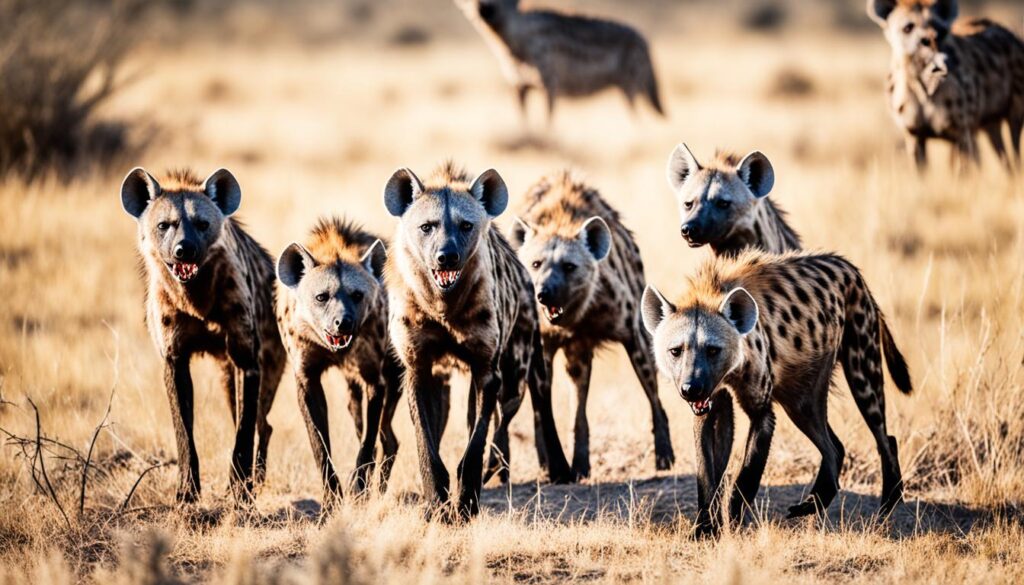
Hyenas as Scavengers
While hyenas are not solely scavengers, they do scavenge when the opportunity arises. They have the ability to smell carcasses from a distance and will take advantage of easy meals. However, it’s important to note that hyenas are also efficient hunters and obtain a significant portion of their food from their own kills.
Hyenas possess a unique adaptive strategy when it comes to feeding, combining both scavenging and hunting techniques. They are opportunistic feeders that take advantage of carrion when available, which allows them to survive in a variety of environments. By relying on their highly acute sense of smell, hyenas can detect carcasses from miles away, enabling them to capitalize on the prey abandoned by other predators or death due to natural causes. This scavenging behavior serves as a critical survival mechanism, particularly in times of food scarcity.
However, hyenas’ role as scavengers should not overshadow their impressive hunting skills. They possess a powerful bite and strong jaws that allow them to crack open bones and consume every part of their prey, ensuring no waste. Hyenas have been observed taking down prey as large as adult zebras and even baby elephants. Their incredible stamina, agility, and coordination in hunting make them formidable predators in their own right.
| Fact | Hyenas as Scavengers | Hyenas as Hunters |
|---|---|---|
| Feeding Behavior | Scavenge when opportunity arises | Efficient hunters, obtain food from own kills |
| Survival Strategy | Utilize carrion for survival | Show impressive hunting skills |
| Diet | Includes scavenged carrion | Consists of diverse range of prey |
| Adaptive Behavior | Smell carcasses from a distance | Use speed, agility, and coordinated hunting techniques |
As scavengers, hyenas play a vital role in maintaining ecosystem balance by efficiently recycling nutrients and reducing the spread of disease through carcass removal. Their ability to adapt and utilize various food sources, combined with their impressive hunting skills, contributes to their success as a resilient and resourceful species.
Now that we’ve explored the scavenging and hunting habits of hyenas, let’s delve into their skills as expert hunters in the next section.
Hyenas’ Hunting Skills
When it comes to hunting, hyenas are truly impressive creatures. Their unique combination of speed, stamina, and teamwork allows them to bring down prey efficiently. Let’s delve into their hunting skills and explore what makes them such formidable predators.
Hyenas have been observed running at incredible speeds of up to 60 kilometers per hour, making them capable of chasing down fleet-footed prey in a matter of seconds. Even more astonishing is their ability to sustain a speed of 40 to 50 kilometers per hour for several kilometers, demonstrating their remarkable stamina in pursuit of a meal.
“Hyenas are incredibly skilled hunters, using their speed, stamina, and teamwork to bring down prey.”
But the true secret to their hunting success lies in their remarkable teamwork. Hyenas are known for their social structure, living in organized clans where cooperation is key. When the clan sets out on a hunt, they work together as a coordinated group, using strategic tactics to surround and overpower their prey.
The sheer strength in numbers often overwhelms their target, allowing them to bring down large ungulates such as zebras, wildebeest, and antelopes. Their powerful jaws and sharp teeth enable them to deliver lethal bites, quickly incapacitating their victims.
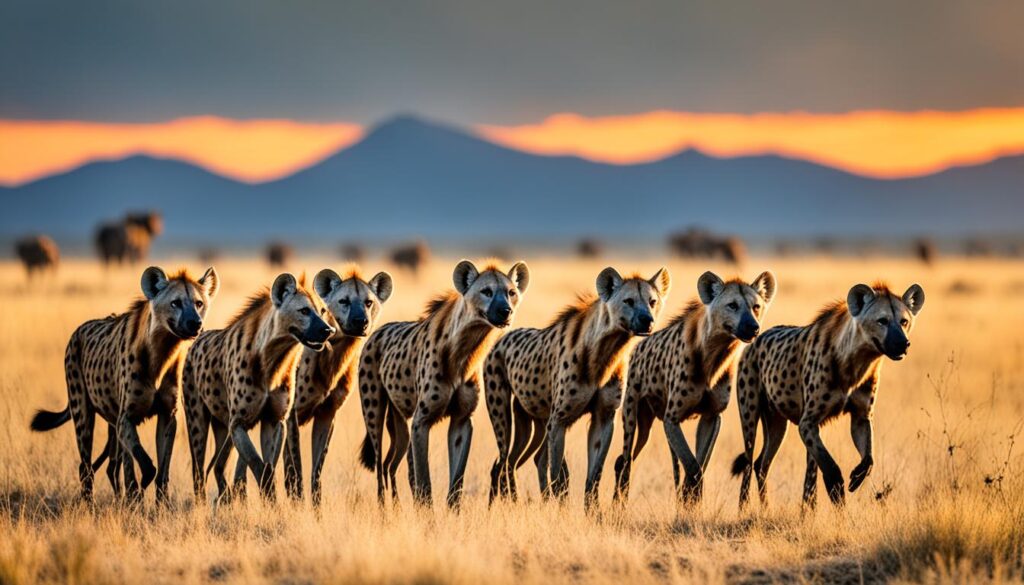
As a testament to their prowess, hyenas have one of the highest hunting success rates among African predators, with some sources estimating it to be as high as 85%. Their exceptional hunting skills provide them with a vital source of sustenance, ensuring their survival in often harsh and competitive environments.
Hyenas’ Cooperative Hunting Tactics
Cooperative hunting is a defining characteristic of hyenas. During a hunt, they employ various strategies to outmaneuver their prey and secure a successful kill. One such tactic is the “creeping approach,” where hyenas stealthily advance toward their target, minimizing the risk of being detected.
Once in range, they initiate a sudden sprint, using their speed and agility to close in on their unsuspecting prey. This swift and coordinated attack often leaves little chance for escape.
In addition to their speed and teamwork, hyenas possess highly developed senses, including acute hearing and a keen sense of smell, which allow them to locate potential prey even from considerable distances. Their extraordinary hunting skills are a testament to their adaptability and efficiency as predatory animals.
Comparing Hyenas’ Hunting Skills to Other Predatory Animals
When it comes to predatory prowess, hyenas are often overshadowed by their fellow African predators, such as lions and cheetahs. However, their collaborative hunting methods and unique adaptations make them equally formidable in their own right.
To gain a clearer perspective, let’s compare the hunting skills of hyenas to those of lions and cheetahs.
| Hyenas | Lions | Cheetahs |
|---|---|---|
| Highly efficient team hunters | Skilled solitary hunters | Exceptional speed and acceleration |
| Can sustain high-speed pursuit over long distances | Utilize stealth and ambush tactics | Capable of reaching incredible speeds in short bursts |
| Reliant on strength in numbers | Ability to bring down large prey alone | Rely on agility and maneuverability |
While each of these predators excels in different aspects of hunting, hyenas’ cooperative nature and unparalleled endurance make them stand out among their competitors.
Understanding hyenas’ hunting skills not only provides insight into their fascinating behavior but also highlights the crucial role they play in maintaining the delicate balance of ecosystems. By working together, hyenas have perfected their hunting techniques, ensuring their survival and contributing to the overall health and diversity of their habitats.
Hyenas vs. Lions
There is a complex relationship between hyenas and lions in the wild. While they are often portrayed as enemies in popular media, the reality is more nuanced. Lions and hyenas will compete for food, and lions may even attempt to kill hyenas to protect their kills. However, hyenas are also known to steal kills from lions. It should be noted that lions are responsible for a significant number of hyena deaths.
“The circle of life moves us all.”
When it comes to the interaction between hyenas and lions, it is important to separate fact from fiction. These two species have a dynamic and intricate relationship in the wild, shaped by their shared habitat and competition for resources.
In the battle for food supremacy, both hyenas and lions have their own tactics. Lions, being apex predators, are fierce and territorial. They establish their dominance through physical encounters and vocal displays, warding off potential rivals, including hyenas. However, hyenas find their own ways to survive and thrive in these challenging conditions.
The social structure of hyenas, which revolves around a matriarchal hierarchy, allows them to form formidable hunting packs. By working together, hyenas can subdue larger prey and secure their own kills, even in the face of competition from lions.
While lions may perceive hyenas as rivals and a threat to their dominance, the reality is that both species rely on a mix of hunting and scavenging to meet their dietary needs. Hyenas are excellent scavengers, capable of detecting carcasses from great distances, and they will swoop in opportunistically to claim a lion’s kill. On the flip side, lions, with their strength and power, often overpower hyenas and drive them away from their prey.
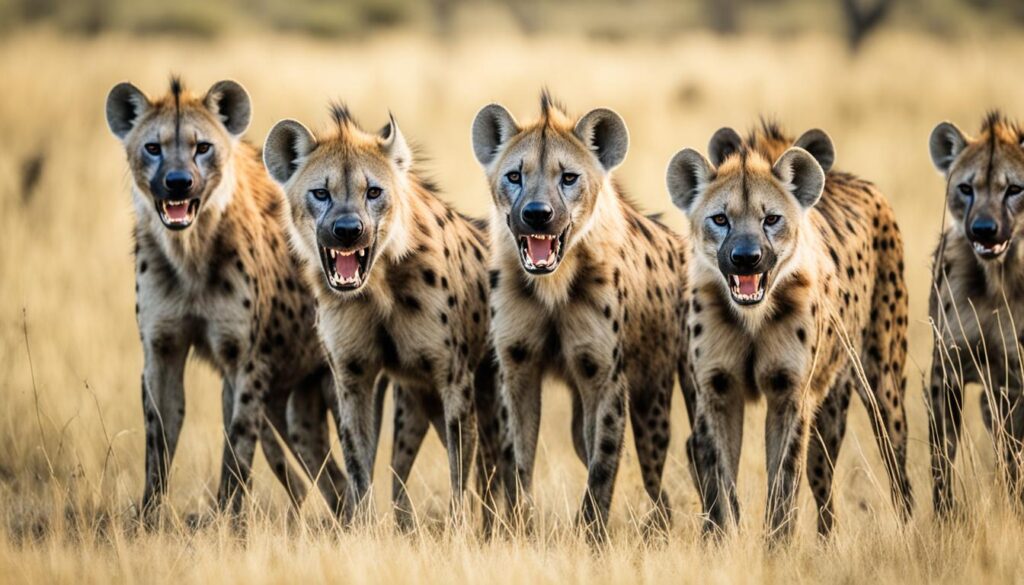
This image showcases the captivating encounter between a hyena and a lion, capturing the intensity and complexity of their relationship. It serves as a reminder that nature is diverse, and interactions between species can be both cooperative and competitive.
It is crucial to acknowledge that the relationship between hyenas and lions is not solely defined by violence and animosity. There have been instances where both species have been observed peacefully coexisting, with hyenas sometimes even following lions to scavenge on their leftovers.
As we delve further into the world of hyenas and lions, we will discover more surprises and intricacies that make these ecosystems truly fascinating. The interconnectedness of all animals, including the predator-prey dynamics, allows for the delicate balance of our natural world to be maintained.
Hyena Social Hierarchy
Within hyena clans, a fascinating social hierarchy exists, with dominant females leading the way. This matriarchal structure ensures a stable and organized community, as females inherit their mother’s rank and work diligently to establish their own position within the hierarchy. It’s quite a competitive process, with female cubs engaging in fierce battles to assert their dominance and secure a higher rank.
However, it’s not just the females who play a vital role in the social dynamics of hyenas. Immigrant males seeking to join a clan must first undergo a period of subordination, proving their loyalty and commitment to the group before they are accepted as members. This period of subordination allows the clan to maintain control and preserve the social balance.
These intricate social dynamics often lead to territorial disputes between different hyena clans. Boundaries are fiercely defended, with clans marking their territories through scent marking and vocal communication. The social hierarchy and territorial system of hyenas contribute to the stability and coordination necessary for their survival in the wild.
The Importance of Hyena Social Structure
The hyena social hierarchy is crucial for the survival and success of the species. The strong leadership of dominant females ensures effective coordination within the clan, allowing for efficient hunting and resource utilization. The complex social interactions and territorial system help maintain order and prevent excessive competition within communities.
“The social hierarchy of hyenas is a remarkable demonstration of cooperative behavior and adaptable group dynamics.”
By working together and respecting the social order, hyenas are able to navigate the challenges of their environment, securing their place at the top of the food chain. This social structure also enhances the clan’s ability to defend its territory and protect its young from potential threats.

| Advantages of Hyena Social Hierarchy | Disadvantages of Hyena Social Hierarchy |
|---|---|
| Efficient coordination during hunts | Potential for internal conflicts and aggression |
| Protection of young and vulnerable members | Less individual freedom and independence |
| Preservation of resources within the clan | Competition for dominance and rank |
The hyena social hierarchy, with its well-defined roles and social interactions, is a captivating aspect of their behavior. It highlights the importance of social cohesion and cooperation for the survival and success of these remarkable creatures.
Hyena Feeding Habits
Hyenas have fascinating feeding habits that showcase their adaptability and efficiency as carnivores. They are known for their ability to consume all parts of a carcass, including bones, utilizing every available resource for sustenance.
One of the remarkable features of hyenas’ feeding habits is their powerful jaws and teeth, specifically adapted for cracking bones. These specialized dental structures allow hyenas to access nutrient-rich marrow inside the bones, providing them with essential minerals and fats.
What sets hyenas apart is their efficient digestion of bone material. They have a robust digestive system that can extract valuable nutrients from bones, making them highly specialized scavengers and hunters.
Hyenas also exhibit a unique behavior of caching food. They often store their surplus kills, hiding them in shallow water to protect the food from other scavengers. This strategic act of food caching ensures that hyenas have a consistent and easily accessible food supply, even during lean times.
“Hyenas’ feeding habits reflect their survival instinct and their remarkable ability to adapt to changing environments. Their consumption of bones and food caching strategies are an integral part of their successful survival strategies in the wild,” says Dr. Lisa Johnson, wildlife biologist.
By consuming all parts of a carcass and effectively utilizing bones, hyenas demonstrate a key role in the ecological cycle. Their feeding habits contribute to nutrient recycling and the maintenance of a balanced ecosystem.
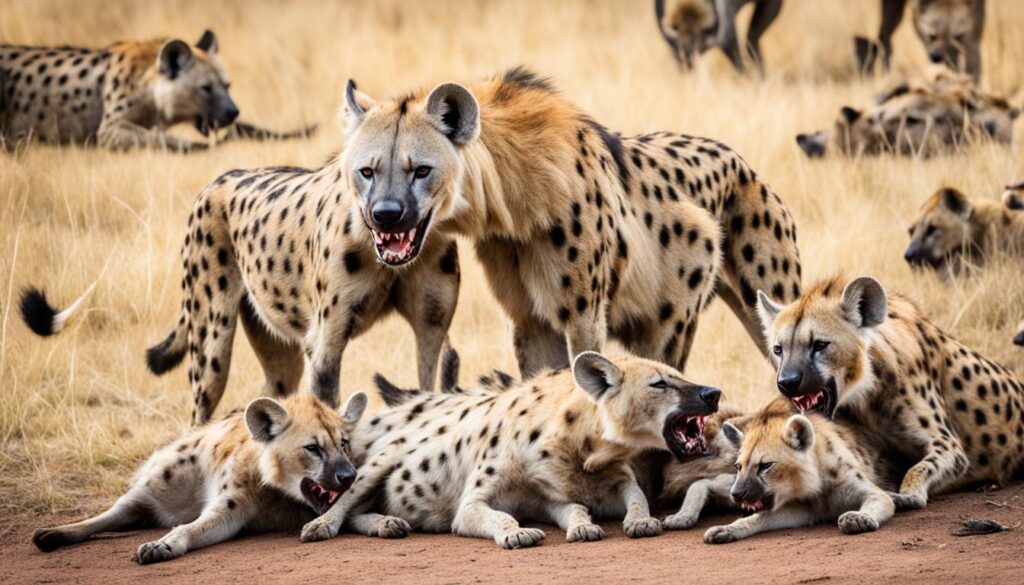
Hyena Feeding Habits at a Glance:
| Feeding Habit | Description |
|---|---|
| Consuming Bones | Hyenas have powerful jaws and teeth adapted for cracking bones, enabling them to access nutritious marrow and extract essential minerals and fats. |
| Efficient Digestion | Hyenas possess a robust digestive system capable of extracting valuable nutrients from bone material, making them adept scavengers and hunters. |
| Food Caching | Hyenas store surplus kills by hiding them in shallow water, preventing other scavengers from accessing the food and ensuring a consistent food supply. |
In conclusion, hyenas’ feeding habits display their unique adaptations and resourcefulness as carnivores. Their consumption of bones, efficient digestion, and food caching strategies are essential components of their dietary behavior, facilitating their survival in diverse environments.
Misconceptions About Hyenas
There are many misconceptions floating around when it comes to hyenas. These fascinating creatures often find themselves subject to inaccurate beliefs and misinformation. Let’s uncover the truth and dispel some of these misconceptions.
1. Hyenas are not Dogs or Cats
Contrary to popular belief, hyenas are not related to dogs or cats. They belong to their own unique family, Hyaenidae, which includes four distinct species: the spotted hyena, brown hyena, striped hyena, and aardwolf. While they do share some physical characteristics with dogs and cats, hyenas have their own evolutionary lineage.
2. Hyenas are Skilled Hunters, not just Scavengers
One common misconception about hyenas is that they are solely scavengers, relying on the leftovers of other predators. However, hyenas are skilled hunters in their own right. They have a powerful bite force and impressive stamina, enabling them to take down large prey such as wildebeest and zebras. While they do scavenge when the opportunity arises, hunting is a significant part of their feeding habits.
3. Hyenas Have Complex Social Structures
Another misconception is that hyenas are solitary animals. In reality, hyenas live in complex social structures known as clans. These clans are led by dominant females, and individuals within the clan have distinct roles and hierarchies. In addition to hunting and scavenging together, hyenas also engage in cooperative care of their young, creating a close-knit community.
“Hyenas are not mindless scavengers; they are highly intelligent and adaptable predators.”
4. Hyenas’ Laugh is Not Always a Sign of Happiness
Hyenas are often associated with their distinctive vocalization, referred to as a “laugh.” Contrary to popular belief, this vocalization is not always a sign of happiness. Hyenas vocalize for various reasons, including communication, establishing territory, and asserting dominance within their social structures.
5. Hyenas Play an Important Ecological Role
Hyenas are often misunderstood and seen as pests or threats. However, they play a vital ecological role as scavengers and predators. By feeding on carrion and controlling herbivore populations, hyenas help maintain the equilibrium of ecosystems. Their presence is essential for the overall health and balance of the wildlife communities they inhabit.
It is crucial to dispel these misconceptions and approach hyenas with a better understanding of their true nature. By doing so, we can appreciate the remarkable qualities and contributions of these incredible creatures.

The Unique Traits of Hyenas
Hyenas possess several unique traits that set them apart from other carnivores. Let’s explore some of these remarkable characteristics:
- Milk Production: Hyenas are the only carnivores that can produce milk for their offspring for over a year. This extended nursing period allows the young hyenas to develop and grow.
- Distinctive Calls: Hyenas are known for their distinctive calls, including the famous “laugh” that is often associated with them. These vocalizations serve various purposes, such as communication within the clan and asserting dominance over rivals.
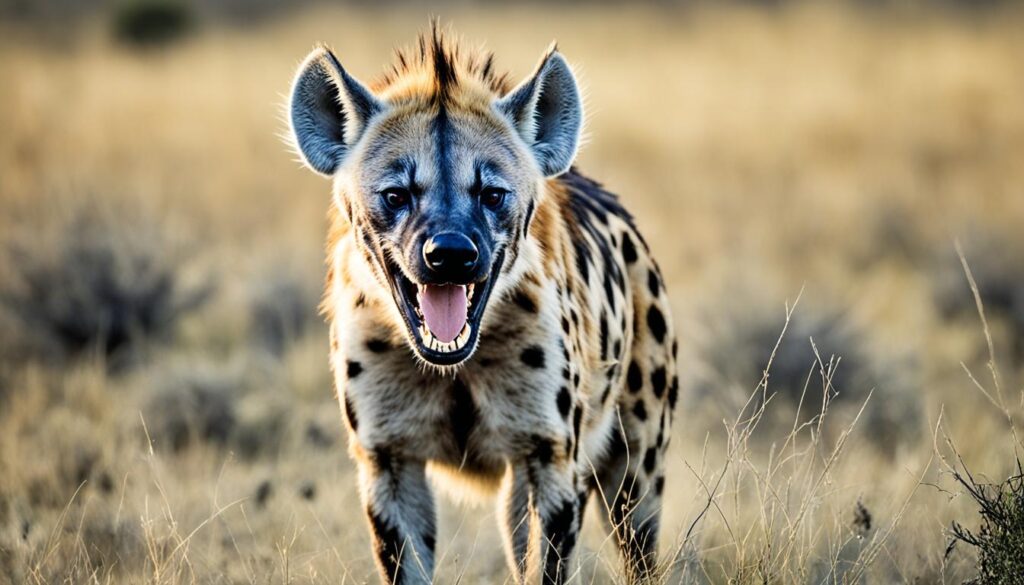
Hyenas and Humans
Hyenas are predominantly wary of human interaction, preferring to keep their distance. However, there have been occasional instances where hyenas have attacked humans, particularly when humans are sleeping outdoors or near their territories. It is essential to exercise caution and respect when encountering hyenas in the wild to ensure the safety of both humans and these remarkable creatures.
In order to minimize potential conflicts, it is advisable to follow these guidelines when in hyena habitats:
- Avoid camping or sleeping in areas known to be frequented by hyenas.
- Ensure that food and waste are stored securely to avoid attracting hyenas to campgrounds.
- Never approach or attempt to feed hyenas, as this can encourage their dependence on humans and lead to aggressive behavior.
- If encountering a hyena in the wild, maintain a safe distance and observe from a respectful standpoint.
Staying Safe in Hyena Territories
While hyenas generally prefer to avoid confrontations with humans, it is crucial to remember that they are powerful and capable predators. By adhering to the following precautions, individuals can minimize the risk of negative encounters with hyenas:
- Travel in groups when exploring hyena habitats, as this can help deter potential attacks.
- Avoid leaving small children unattended in areas known to be inhabited by hyenas.
- If camping outdoors, ensure that tents and sleeping areas are secure and situated away from hyena territories.
- Do not provoke or startle hyenas by making loud noises or sudden movements.
“We must remember that hyenas are unique and important members of our ecosystem. By understanding their behavior and taking appropriate precautions, we can coexist with these fascinating creatures and appreciate their role in the natural world.” – Dr. Jane Wilson, Wildlife Conservation Expert
| Hyenas and Humans – Quick Safety Tips | Hyenas and Humans – Importance of Coexistence |
|---|---|
| ✅ Travel in groups when in hyena habitats | ✅ Appreciation of hyenas’ unique ecological roles |
| ✅ Securely store food and waste to avoid attracting hyenas | ✅ Minimizing conflicts through education and precaution |
| ✅ Never approach or attempt to feed hyenas | ✅ Respecting hyena territories and natural behavior |
| ✅ Maintain a safe distance when encountering hyenas | ✅ Ensuring the safety of humans and hyenas |

Conservation of Hyenas
Hyenas, like many other wildlife species, are facing significant threats to their survival due to habitat loss and human-wildlife conflict. As their natural habitats continue to shrink, hyenas are pushed into smaller and fragmented areas, making it harder for them to find food, water, and suitable shelter.
To ensure the long-term survival of hyenas, it is crucial for us to implement effective conservation efforts. By protecting and restoring their natural habitats, we can provide hyenas with the resources they need to thrive. This includes preserving large, intact landscapes where hyenas can hunt, scavenge, and establish stable social structures.
Another important aspect of hyena conservation is mitigating human-wildlife conflict. As human populations expand and encroach upon hyena habitats, conflicts can arise from livestock predation or perceived threats to human safety. It is vital to work with local communities to find sustainable solutions that benefit both humans and hyenas.
“Conservation is a race against time, and we must act now to protect hyenas and their habitats.”
Education and awareness also play a critical role in hyena conservation. By raising awareness about the ecological importance of hyenas and dispelling misconceptions, we can foster a greater understanding and appreciation of these remarkable animals. This can lead to stronger support for conservation initiatives and policies.
Furthermore, research and monitoring are instrumental in guiding conservation efforts. By studying hyena populations and their behaviors, we can gain valuable insights that inform conservation strategies and help us make informed decisions about their management.
Through collaborative efforts among researchers, conservation organizations, local communities, and governments, we can ensure a brighter future for hyenas. Together, we can safeguard their habitats, mitigate conflicts, and promote coexistence between humans and hyenas.
Conservation Strategies for Hyenas:
- Protecting and restoring natural habitats
- Mitigating human-wildlife conflict
- Engaging and educating local communities
- Supporting research and monitoring efforts
- Advocating for strong conservation policies
Threats to Hyena Conservation
| Threat | Description |
|---|---|
| Habitat Loss | Deforestation, habitat fragmentation, and urbanization |
| Human-Wildlife Conflict | Encounters with humans, livestock predation, and retaliatory killings |
| Poaching | Illegal hunting for body parts and traditional medicine |
| Climate Change | Altered weather patterns and habitat suitability |

Conclusion
In conclusion, hyenas are fascinating creatures with a diverse diet and impressive hunting skills. Contrary to popular belief, hyenas are not solely scavengers, but also skilled hunters who rely on both fresh kills and scavenged carrion to sustain themselves.
Their interactions with other predators, such as lions, add to their intriguing behavior. While there may be competition between hyenas and lions for food, hyenas are known to steal kills from lions as well. The relationship between these two apex predators is complex and goes beyond simple enemies.
Understanding the true nature of hyenas is crucial for their conservation efforts and for dispelling misconceptions. By recognizing their hunting abilities and the vital role they play in ecosystems, we can appreciate these remarkable animals and work towards their protection.










